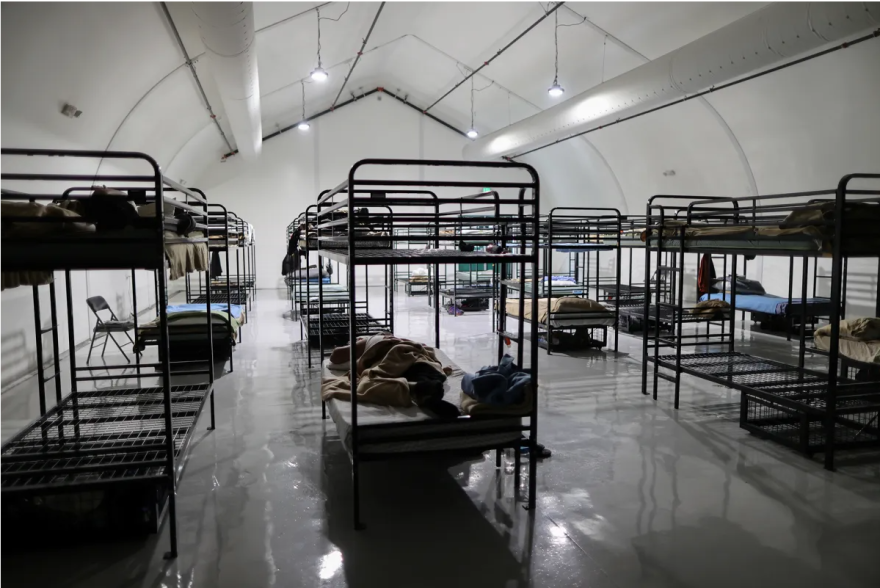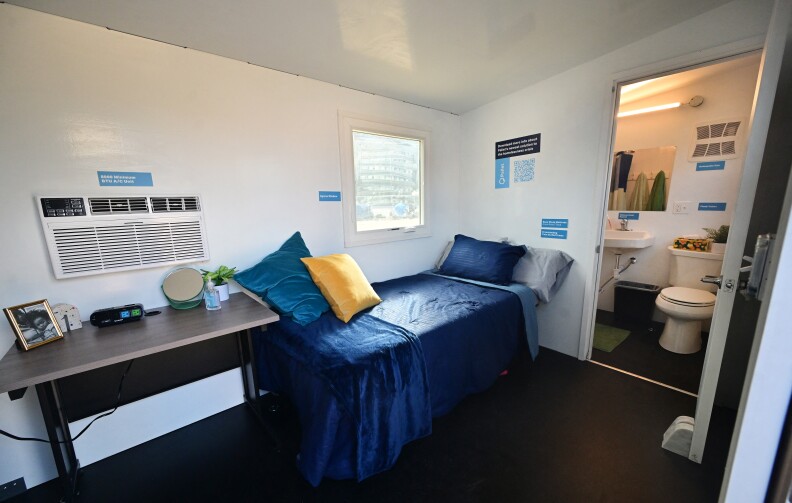Congress has cut federal funding for public media — a $3.4 million loss for LAist. We count on readers like you to protect our nonprofit newsroom. Become a monthly member and sustain local journalism.
How a new real-time database could match LA's unhoused people with shelter beds

The Los Angeles area’s largest homeless services system is using a new, real-time digital database to track shelter bed availability in an effort to reduce wait times for thousands of unhoused residents.
Starting July 1, the tool will be used to automatically match unsheltered people with beds, according to the Los Angeles Homeless Services Authority. Previously, the agency known as LAHSA, used a patchwork of spreadsheets to monitor when beds became available, a process that was often slow and inefficient.
“ There were a lot of challenges tracking inventory in the past,” said Bevin Kuhn, the agency’s deputy chief analytics officer, at a LAHSA Commission meeting last month. "We're gonna let the computer do a lot of that thinking.”
L.A. County is home to more than 75,000 unhoused residents, according to LAHSA’s latest count, and a lack of available shelter beds is a chronic problem.
The agency funds about 16,000 “interim housing” beds across L.A. city and county — a category that includes motel rooms, congregate shelters and tiny homes. There are consistently about 5,000 people on wait lists for those shelter beds, according to the agency.
On the other hand, thousands of shelter beds can sit empty on any given night because providers often don’t know which beds are available and where, according to LAHSA.
A 2024 L.A. City Controller’s audit examining the city’s shelter system found that 1 in 4 LAHSA shelter beds sat empty, and the agency had “severe data quality issues.” The report also called on LAHSA to formalize its reservation system for shelter beds.
LAHSA did not respond to multiple requests for comment about its new shelter inventory system.
Homelessness officials and service providers say they want efficiency, but they also have concerns about automating the shelter system and losing human interaction, which they say many unhoused clients need.
"Call me archaic, but I will always think you need a lot of people involved when you're dealing with vulnerable people,” LAHSA Commissioner Amy Perkins said at the April meeting. “So computers will never be able to do this.”
How it works
LAHSA first tested its new bed inventory tracking system in January 2024 with the city’s Inside Safe and county’s Pathway Home programs, both of which focus on moving people out of encampments and into hotels.
The new database is built into an existing database called the Homeless Management Information System that service providers were already using to track clients.
The new system captures detailed information about each shelter, including bathroom and kitchen facilities, accessibility features for people with disabilities and other requirements, such as they only accept a particular gender or age group.
The database allows shelter managers and outreach teams to see why some beds might be offline. It also shows users who is currently staying in each room or bed in the system.
Service providers are responsible for updating the system every morning. LAHSA officials say this fixes a problem in which the systems showed that beds were occupied long after clients had left because providers were waiting to complete paperwork before updating the system.
Homeless services providers underwent training from LAHSA and started working with the new system earlier this year.
Ben Kay, who works for homeless services provider HOPICS, told LAHSA commissioners last month that the agency needed more input from people on the front lines — like those who work with outreach and intake — before overhauling its shelter management system.
“ The growing pains are not going to be felt at [the commission] level,” Kay said. “They're not gonna be felt by those who have made this decision. They're gonna be felt by the people who are doing the work and those on the street.”
Laura Harwood, deputy chief program officer at Hope the Mission, said her organization has been using the software for the past few weeks. She’s optimistic about it, but cautioned that it’s hard for shelter operators to take on new technology.
“With rising costs, declining donations, service cuts and leadership changes at LAHSA, the capacity to absorb and execute new initiatives like this one is being tested,” she said.
Since March, some of the information on shelters has been available to the general public through an online dashboard, but it’s not updated daily. The dashboard allows users to monitor interim housing occupancy rates, track the availability of beds across different regions and learn why certain beds might be offline.
The dashboard has information about more than 11,000 LAHSA-funded shelter beds. As of Monday, about 80% of were occupied, according to the dashboard. However, officials said that figure may be inaccurate because not all providers have finished entering data. About 3% of the total units are offline.

Matching clients with shelter
LAHSA plans to launch the next phase of the system in July by automating the matching process. Currently, service providers are manually matching clients with available beds using a disjointed spreadsheet system and making phone calls.
The new system will start off somewhat slowly, with more than half of the 11,000 beds in the inventory being automatically matched. When matches are made, case managers will receive email notifications and can schedule intake appointments.
Clients will have 24 hours to accept a match and 48 hours to arrive at the facility before the bed is released.
Matches will be made based on criteria developed by LAHSA and L.A. County. Priority is given to clients who need to be moved from other shelters, including victims of crime, people with accessibility needs and those in programs that are shutting down. People who are highly vulnerable or have been waiting longest will also be prioritized.
Perkins cautioned LAHSA about relying too much on technology because new systems don’t always work as intended.
“Of course it sounds great on paper, but I don't know, I'm just nervous,” Perkins said. “The more you centralize and take people out of things, it sounds great, but then it doesn't always translate.”
Harwood from Hope the Mission urged LAHSA to keep its teams of staffers dedicated to matching clients with housing.
“The human element that matchers provide is essential,” she said. “Replacing that entirely with automation could feel as frustrating as being trapped in a phone system loop.”
LAHSA officials acknowledged those concerns and emphasized that human expertise remains central to the process. Kelsey Madigan, LAHSA’s director on interim housing, said it’s a running joke among the matching team that they could be replaced by robots.
“I'm like, 'No, we need you,'" she said. "It takes an entire team to support matching.”
As Editor-in-Chief of our newsroom, I’m extremely proud of the work our top-notch journalists are doing here at LAist. We’re doing more hard-hitting watchdog journalism than ever before — powerful reporting on the economy, elections, climate and the homelessness crisis that is making a difference in your lives. At the same time, it’s never been more difficult to maintain a paywall-free, independent news source that informs, inspires, and engages everyone.
Simply put, we cannot do this essential work without your help. Federal funding for public media has been clawed back by Congress and that means LAist has lost $3.4 million in federal funding over the next two years. So we’re asking for your help. LAist has been there for you and we’re asking you to be here for us.
We rely on donations from readers like you to stay independent, which keeps our nonprofit newsroom strong and accountable to you.
No matter where you stand on the political spectrum, press freedom is at the core of keeping our nation free and fair. And as the landscape of free press changes, LAist will remain a voice you know and trust, but the amount of reader support we receive will help determine how strong of a newsroom we are going forward to cover the important news from our community.
Please take action today to support your trusted source for local news with a donation that makes sense for your budget.
Thank you for your generous support and believing in independent news.

-
The brothers have been in prison for more than three decades for the shotgun murders of their parents, Jose and Kitty Menendez, at their Beverly Hills home in August 1989.
-
The decision follows a years-long effort to free Erik and his brother Lyle who are both serving life sentences for the 1989 shotgun slayings of their parents. Lyle Menendez has his hearing Friday.
-
Unite Here Local 11 is already fighting for a $30 minimum wage. Now it's asking Olympics organizers to give $5 billion to new housing and ditch Airbnb.
-
Climate policies could lead to future refinery closures as Californians transition to electric vehicles.
-
A slim majority said Senate Bill 79 would take away the city’s control over housing growth. Other council members said the city is failing to confront the crisis.
-
Critics say the cash-strapped system misspent millions of dollars getting upgraded accounts for all students. CSU leaders insist they're needed to meet a changing economy.










